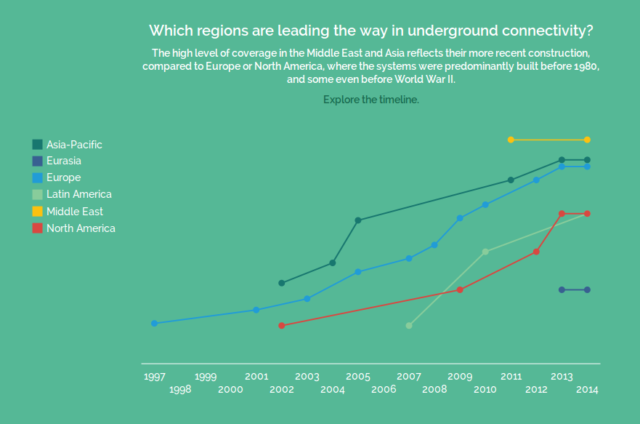
Why We Need to be Online and Underground
July 28, 2014 — Blog
As many cities continue to grow at an astonishing rate, so too will the demand for better urban mobility. Seamless Internet connectivity can be used as a tool to develop world class public transportation systems, giving citizens the freedom and flexibility they desire. This incentivizes against excessive car use, ensuring more livable and competitive urban centers.
According to Online and Underground, a survey launched earlier this spring by NewCities, the International Association of Public Transport (UITP), Ericsson and FABERNOVEL, 77% of surveyed subway systems provide their customer with some level of Internet access, either in stations (73%) or on-board trains (58%). Over the next 3 years, 68% of surveyed subway systems plan on extending broadband connectivity in their existing stations.
Extending into one of the last Internet-free urban reaches, underground connectivity is arguably an unnecessary or unwelcome over-saturation. In an age where connectivity matters, however, cities are increasingly pulsing with bustling herds of urban travelers furtively glancing at their phones. While some of this is motivated by a desire to bag another “like” or avoid potentially awkward and confrontational eye-contact with strangers, being online is increasingly essential to many citizens’ urban experience as it provides them with the freedom and flexibility they desire. This latter point matters for the future of cities.
Cities should strive to offer seamless Internet connectivity.
Cities are growing at an astonishing rate, some expected to double or even triple in the near future. Gridlocked urban traffic is widely recognized as environmentally, economically and socially expensive. As the arteries and veins of the city, public transport – and underground transportation infrastructure in particular – is essential to absorbing this rising demand for mobility. While public transport is often burdened by the negative stigmatization of being old, dilapidated, uncomfortable and unreliable, cities should strive to reverse this stigma and offer their citizens state-of-the-art, seamless Internet connectivity on public underground transportation networks.
The connected commute… is economically and socially valuable.
The connected public transport commute, as opposed to an hour of dead time in traffic, can be used to get a head-start to the day, be it clearing an inbox, reviewing the news or catching up with friends. Doubling as a mobile workspace, the connected carriage is thus economically and socially valuable. It helps unlock underutilized time, both for classic commuters and the growing class of flexible workers on the go.
This increased flexibility will ultimately help ensure more livable urban centers. The advantage of being able to stay productive while commuting forms a key incentive against excessive personal vehicle use, and thus urban congestion. Just as in-flight Internet connectivity is a game-changer for many frequent travelers, so too will being able to continue working during extended underground journeys.
A key challenge is providing customers with sufficient space and comfort to work, without compromising overall carrying capacity. While coping with peak demand during rush hour remains the top priority, solutions could include designing flexible carriages which offer collapsible, or even dedicated, working environments.
Unfeasible for the majority of short commutes involving multiple carriage changes, these solutions are particularly relevant for extended single-train journeys between urban cores. This includes urban corridors such as Paris-London, as well as growing multi-core urban megapolises such as the Bohai Sea Ring or Pearl River Delta. These vast inter-city economic regions will face skyrocketing commuting times, particularly as concerns over climate change and rising oil prices mean air travel may not remain a feasible option. Integrated networks of mobile ‘work pods’ – with all the comfort and functionality of a coworking space – could fulfil mobility requirements for workers managing multiple projects or regularly attending meetings over vast geographical regions. Ultimately, these will also serve to ensure a region’s economic dynamism and competitiveness.
Find out more using our online tool.

The views expressed here are those of the author and do not necessarily reflect those of NewCities or any other organization.